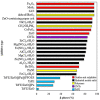Solution Blow Spinning of Polyvinylidene Fluoride Based Fibers for Energy Harvesting Applications: A Review
- PMID: 32517387
- PMCID: PMC7362018
- DOI: 10.3390/polym12061304
Solution Blow Spinning of Polyvinylidene Fluoride Based Fibers for Energy Harvesting Applications: A Review
Abstract
Polyvinylidene fluoride (PVDF)-based piezoelectric materials (PEMs) have found extensive applications in energy harvesting which are being extended consistently to diverse fields requiring strenuous service conditions. Hence, there is a pressing need to mass produce PVDF-based PEMs with the highest possible energy harvesting ability under a given set of conditions. To achieve high yield and efficiency, solution blow spinning (SBS) technique is attracting a lot of interest due to its operational simplicity and high throughput. SBS is arguably still in its infancy when the objective is to mass produce high efficiency PVDF-based PEMs. Therefore, a deeper understanding of the critical parameters regarding design and processing of SBS is essential. The key objective of this review is to critically analyze the key aspects of SBS to produce high efficiency PVDF-based PEMs. As piezoelectric properties of neat PVDF are not intrinsically much significant, various additives are commonly incorporated to enhance its piezoelectricity. Therefore, PVDF-based copolymers and nanocomposites are also included in this review. We discuss both theoretical and experimental results regarding SBS process parameters such as solvents, dissolution methods, feed rate, viscosity, air pressure and velocity, and nozzle design. Morphological features and mechanical properties of PVDF-based nanofibers were also discussed and important applications have been presented. For completeness, key findings from electrospinning were also included. At the end, some insights are given to better direct the efforts in the field of PVDF-based PEMs using SBS technique.
Keywords: (nano)fibers; PVDF; SBS; nanofillers; piezoelectricity.
Conflict of interest statement
The authors declare no conflict of interest.
Figures

















References
-
- Ikeda T., Ikeda T. Fundamentals of Piezoelectricity. Oxford University Press; Oxford, UK: 1990.
-
- Boussaa S.A., Kheloufi A., Zaourar B., Kerkar F. Valorization of Algerian Sand for Photovoltaic Application. Acta Phys. Pol. A. 2016;129:133–137. doi: 10.12693/APhysPolA.130.133. - DOI
-
- Castro N., Pereira N., Cardoso V.F., Ribeiro C., Lanceros-Mendez S. Micro- and nanostructured piezoelectric polymers: Fundamentals and application. Front. Nanosci. 2019;14:35–65. doi: 10.1016/B978-0-08-102572-7.00002-7. - DOI
-
- Jbaily A., Yeung R.W. Piezoelectric devices for ocean energy: A brief survey. J. Ocean Eng. Mar. Energy. 2015;1:101–118. doi: 10.1007/s40722-014-0008-9. - DOI
-
- Kepler R.G., Anderson R.A. Piezoelectricity in polymers. Crit. Rev. Solid State Mater. Sci. 1980;9:399–447. doi: 10.1080/10408438008243576. - DOI
Publication types
Grants and funding
LinkOut - more resources
Full Text Sources
Research Materials

